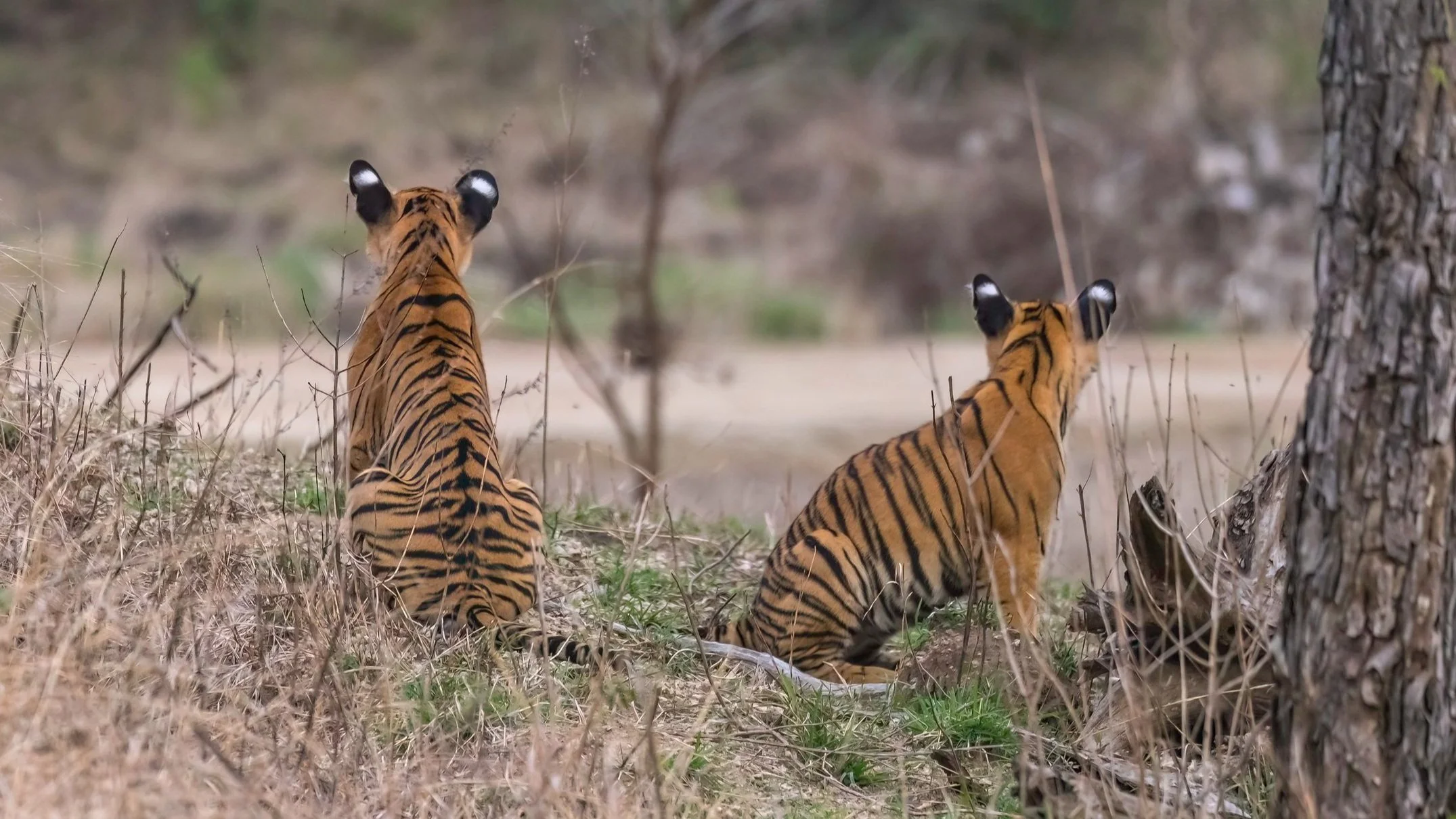Celebrating International Tiger Day
Imagine a world without tigers! No regal stripes cutting through the jungle, no powerful roars echoing across the grasslands, no piercing amber eyes watching from the shadows. This isn’t just a grim fantasy - it is a future we’re racing towards - but today, July 29th, we are fighting back
Welcome to the International Tiger Day, 2025!
#wildartworks, #Canon, #conservationphotography, #yesbbcearth, #wildlifeonearth, #bbcearth, #natgeowild, #natgeoindia, #india, #telanganabirds, #kawaltigerreserve, #amrabadtigerreserve, #nagarjunasagarsrisailamtigerreserve, #hyticos, #tigerconservation, #internationaltigerday, #internationaltigerday2025, #tigerdaycelebrations, #tigerdayevent, #glandpharma, #telanganastateforestdepartment, #tsfd,
Grey-headed Swamphen
A very large bluish-purple waterbird with a red bill and forehead shield, as well as red legs and feet with long toes. The tail is flicked up often, revealing fluffy white “underpants.” Juveniles are duller than adults and lack the red bill and shield. An inhabitant of marshy, vegetated freshwater bodies such as swamps, rivers, and lakes; usually in small groups. Feeds, often clumsily, at muddy water edges, in reeds, and on floating vegetation. Makes short nasal grunts and croaking sounds. Formerly part of the species known as Purple Swamphen.
#wildartworks, #Canon, #Bird, #Birdinginthewild, #BirdWatching, #Wildlife, #WildBirds, #naturephotography, #your_best_birds, #planetbirds, #earthcapture, #photo_pond, #earthpix, #naturyst, #conservationphotography, #yesbbcearth, #wildlifeonearth, #bbcearth, #natgeowild, #natgeoindia, @globalcapture, #india, #telanganabirds, #kawaltigerreserve, #hyticos
Teer/ Arrowhead
Each time you enter the jungles of central India you are in the realm of some of the most varied wildlife in India. This time we were out searching for the reclusive Teer/ Arrowhead - named by Ajinder Singh for the distinct arrow or “teer” on his forehead. Born in February 2023, he was one of 3 cubs from the 5th litter of the Legendary Talabwali Tigress with Zanjeer.
#wildartworks #wildlifephotography #tipeshwarwildlifesanctuary #conservationphotography #tiger #tipeshwartiger #indianwildlifeofficial #wildlifeonearth #bbcearth #natgeowild #natgeoindia #bigcatswildlife @bigcatswildlife #maharashtra #ajindersingh @ajinder123 #ajinder123 #tigertalesecoresort #tigertalestipeshwar #arrowheadtiger #teertiger #tipeshwarwildlife #arrowhead #teer
The Tipai Leopard
The elusive leopard, a ghost of the forests, is often hailed as its most elegant dweller. The area around the Tipai Mata temple in Tipeshwar is a compact patch of dense forest cover with a number of old and mature trees and is prime habitat for leopards. It was about 7am on the morning of 8th June when we got word of this leopard lazing in a tree just below the mandir.
#wildartworks #wildlifephotography #tipeshwarwildlifesanctuary #jungle #wild #forest #wildlife #conservationphotography #indian_wildlifes #indianwildlifeofficial #wildlifeonearth #bbcearth #natgeowild #natgeoindia #animalsofinstagram #bigcatswildlife @bigcatswildlife #leopardsoftipeshwar #leopard #pantherapardus #pardus #landofleopards #maharashtra #ajindersingh @ajinder123 #ajinder123 #tigertalesecoresort #tigertalestipeshwar #veertiger #arrowheadtiger #teertiger #4marktigress #architigress #tipeshwarleopard #tipeshwarwildlife
Gray Junglefowl/ Sonnerat's Junglefowl
The Gray Junglefowl, also known as Sonnerat's Junglefowl, is one of the wild ancestors of the domestic chicken together with the Red Junglefowl and other junglefowls. The species epithet commemorates the French explorer Pierre Sonnerat.
#wildartworks, #wildlifephotography, #jungle, #Wild, #forest, #Wildlife, #conservationphotography, #wildlifeonearth, #bbcearth, #natgeowild, #natgeoindia, #Kabini, #Pench, #Tadoba, #tipeshwar, #GrayJunglefowl, #junglefowl, #fowl, #SonneratsJunglefowl,
Red Junglefowl
This “original chicken” is smaller than its domestic descendants, and is widespread throughout South & Southeast Asia and can also be found as an introduced species in many regions around the world (especially prevalent on many Pacific Islands, including Hawaii). In its introduced range and some areas of its native range it has interbred widely with feral and domestic chickens, producing intermediate hybrids. Many of these birds cannot be distinguished from genuine wild-type birds. Within native range calls are useful for ID: the wild male’s crowing is hoarse and choked off towards the end, unlike the loud, vibrant calls of the domestic rooster.
#wildartworks, #wildlifephotography, #jungle, #Wild, #forest, #Wildlife, #conservationphotography, #wildlifeonearth, #bbcearth, #natgeowild, #natgeoindia, #windsornaturetrail, #Kabini, #pench, #Tadoba, #tipeshwar, #BishanAngMoKio, #KaengKrachan, #redJunglefowl, #junglefowl, #fowl, #pheasant,
Hanuman Langur/ Gray Langur
The Hanuman/ Northern Plains Gray Langur (Semnopithecus entellus), also known as the sacred langur, Bengal sacred langur, a species of primate in the family Cercopithecidae. Found across a large part of India south of the Himalayas down to the Tapti & Krishna Rivers.
#wildartworks, #jungle, #wildlifephotography, #tipeshwar, #tipeshwarwildlifesanctuary, #tadoba, #pench, #tadobaandharitigerreserve, #conservationphotography, #indian_wildlifes, #indianwildlifeofficial, #wildlifeonearth, #bbcearth, #natgeowild, #natgeoindia, #hanumanlangur, #GrayLangur, #northernplainsgraylangur, #sacredlangur, #bengalsacredlangur, #langur,
Eurasian Hoopoe
An unmistakable cinnamon coloured bird with a zebra-striped wings, a Chinese fan of a crest (usually held closed, but often raised just after landing), and a rapier of a bill. The hoopoe favours semi-open habitats such as heathland, farmland, orchards, grassy lawns, where it feeds on the ground, probing with its long bill for insects.
#wildartworks, #wildlifephotography, #kabini, #jungle, #Wild, #nagarholetigerreserve, #nilgiribiosphere, #nagarhole, #kabinibackwaters, #conservationphotography, #indian_wildlifes, #indianwildlifeofficial, #wildlifeonearth, #bbcearth, #natgeowild, #natgeoindia, #nammakarnataka, #tipeshwar, #Tadoba, #tadobaandharitigerreserve, #yawatmal, #penchnationalpark, #pench, #telanganabirds, #Manjeera, #AmeenpurLake, #ananthagiriforest, #NarsapurForest, #bhigwanbirdsanctuary









